


Starfire Tor is the
discoverer and chief researcher of Time Shifts, The Core
Matrix, and Co-Existing Time Lines. These are terms
she coined to describe astounding interconnected phenomenon
in which our reality and dominant current time line is
constantly being edited and restructured.
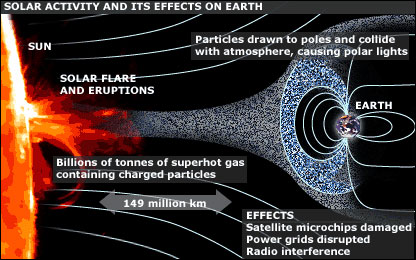
To learn more about this
ground breaking work please listen to Starfire Tor's many
interviews, including the ones with Whitley Strieber on
Dreamland and her many appearances on Coast to Coast AM with
Art Bell, George Noory and Whitley Strieber.
The Time Shift Alerts presented by Starfire Tor do not represent all Time Shifts or Time Shift Alerts. Nor does this Time Shift information present all Time Shift science or scientific results. The purpose of sharing this sampling is to educate people about the science of Time Shifts. Part of this Time Shift Alert education involves historical events including the September 11, 2001 attacks in the U.S., the December 26, 2004 earthquake and tsunami in the Sumatra-Indonesia region, and the March 11, 2011 earthquake and tsunami in Japan.
![]()
DATE SPECIFIC DATA
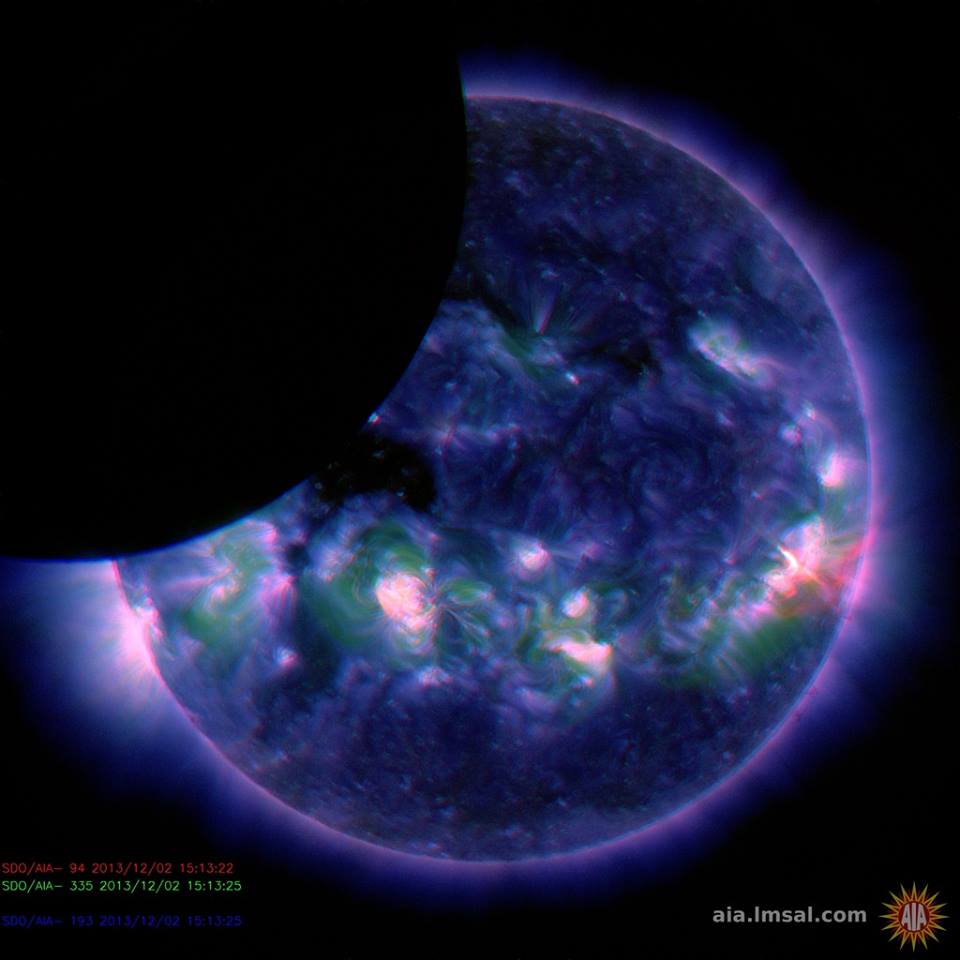
| Lunar Eclipse Between SDO Camera and Sun December 2, 2013 Take a look at this interesting photo of the Sun, which was taken today - December 2, 2013 - by the SDO space camera. Notice anything odd, like a big circular chunk seemingly missing from the Sun? Wonder what that is? Allow me to enlighten you. What happened, is that the Moon transited between the Sun and the SDO space camera. The result was an eclipse of the Sun from the camera's POV. I should also point out that this camera eclipse happened about a day after Comet ISON had its meet and farewell with the Sun. Ordinarily this eclipse, had it happened during the comet's run at the Sun, would have prevented Earth from seeing part of that run. But as it happens, the SDO cameras were unable to see anything of comet ISON while the SOHO photos caught the comet action coming and going. A big thanks to SOHO, which did a great job in getting Comet ISON images processed as rapidly as possible. This near real time view was invaluable. I have more to show you about what happened to ISON. But let's not 'dis' SDO for failing to grab comet images. That was just the way their cameras are set up to view the Sun. Unlike SOHO, that uses an occluding disc so that we can see what is happening around the Sun - such as coronal mass ejections [CME] and Sun diving comets, SDO is set up to see the Sun itself - thus they do not use an occluding disc in their imaging. Instead they use different filters so that we can see the Sun directly. Likewise, SOHO could not have captured this specialized lunar eclipse for the same reasons. |
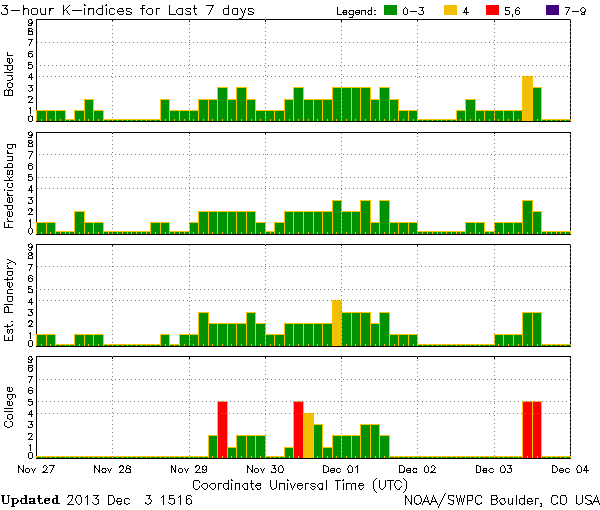
| December
3, 2013 Time Shift Alert Geomagnetic Storm In Progress Time Shift And Time Line Edits In Progress As you can see in this K-index chart from NOAA, by the red and yellow graph columns, Earth is currently experiencing geomagnetic storm conditions and unsettled magnetic field conditions. Time Shift and time line edit activity is in progress, and has been in progress since November 29, 2013. Today's December 3, 2013 geomagnetic storm activity was triggered by the Earth directed coronal mass ejections [CME] that erupted during Comet ISON's approach and slingshot maneuver with the Sun. The earlier November 29, 2013 geomagnetic storm activity - which continued through November 30, 2013 - was triggered by general solar wind conditions and a general tipping of Earth's magnetic field. The conditions faded out by December 1, 2013 and then returned today with the CME hit. So stay sharp and be as aware as you can of Time Shift markers. These markers are the best evidence that a Time Shift is in progress. |
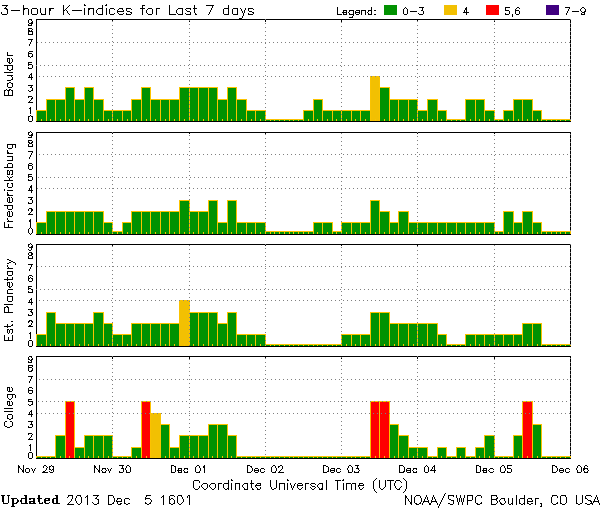
| December
5, 2013 Time Shift Alert Geomagnetic Storm In Progress Time Shift And Time Line Edits In Progress Have a look at this latest NOAA k-index chart, showing that we are once again experiencing geomagnetic storm and unsettled magnetic field conditions. Looking at the chart, you can see the pattern of Earth directed coronal mass ejections [CME] hitting Earth, with the CME having erupted about 3 days before the Earth hit. Time Shift and time line edit activity is also in progress, which has become somewhat normal for this type of Sun-Earth connection of energy. Even as I report this, more sunspots and magnetic filaments are firing off on all sides of the Sun. Remember that the Sun is experiencing solar maximum conditions, and that it will soon complete the north to south reversal [flip] of the solar magnetic poles. Read my November 18, 2013 report - on this wall and my website - explaining interesting details about the solar pole flip. It's one of my 'must read' articles. So stay sharp and be as aware as you can of Time Shift markers. These markers are the best evidence that a Time Shift is in progress. |
| Nelson
Mandela Dies Again At Age 95 December 5, 2013 One Of The Best Known Time Shift Living Dead Nelson Mandela, one of the best known Time Shift Living Dead [TSLD] people - as well as being internationally known as a South African freedom hero, and later President - has died again today at the age of 95. I did not know when exactly he would die again, except that I knew that it would have to be while a Time Shift was in progress. Much earlier today I posted about the current Time Shift and time line edit activity that was in progress. It is still in progress. Here is refresher info about my Time Shift Living Dead research. Please read my article to better understand the science/psience of the Time Shift Living Dead enigma, and how it ties into Time Shift activity and our ever changing co-existing time lines. In short, Time Shift created co-existing time lines produce dual or multiple time line memory conflicts. Usually the brain follows a Core Matrix program that causes the brain to shelve and mask all previous co-existing time line memories while retaining only conscious information about the current co-existing time lines aka the dominant time line. All living brains are controlled by this program. But when a Core Matrix program glitch allows the brain to fight off Core Matrix program-brain assimilation, and thus retain partial memories of other co-existing time lines, the brain then experiences dual or multiple co-existing time line memory conflict. A person or animal can be alive in one co-existing time line while being dead in another co-existing time line. When this happens, the experiencer is left with different authentic memories that are dramatically different - including whether someone is alive or dead. http://www.starfiretor.com/Articles+Reports/TSLD.htm A Time Shift Living Dead event is one of the most important Time Shift markers that a person can experience. A Time Shift Living Dead experience can be mind-boggling and confusing for those unfamiliar with my Time Shift research into the "alive again/dead again" enigma. Those familiar with my Time Shift research, which includes Nelson Mandela, recognize the value of a Time Shift Living Dead experience. Anyone who has a Time Shift Living Dead experience has literally had a mind expanding experience. This mind expanding experience has allowed your brain to become consciously aware that there is more than one time line. There are many co-existing time lines, which is a major part of the Time Shift Living Dead mechanism. Once this part of the brain is switched on it remains on, and that is a very good thing. BTW - One of the places that I talked about Nelson Mandela being a Time Shift Living Dead person - besides in the many reports I've written - was when I was on Art Bell's Coast To Coast on November 20, 2009. Art Bell revealed that he too retains a memory of Nelson Mandela have died before, even though at the time of the radio show Nelson Mandela was alive. Art Bell is only one of thousands of people who have reported the same dead again/alive again experience concerning Nelson Mandela. As I said, in my above report, Nelson Mandela is one of the world's best known Time Shift Living Dead people. |
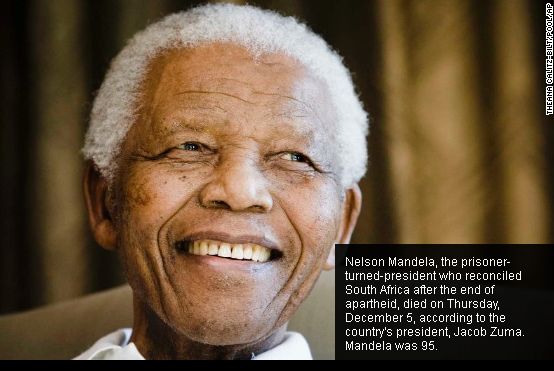
Nelson Mandela, anti-apartheid icon and father of modern South Africa, diesupdated 9:44 PM EST, Thu
December 5, 2013
STORY HIGHLIGHTS
Watch 'Mandela Remembered' tonight on CNN at 9 p.m. ET (CNN) -- Freedom fighter, statesman, moral compass and South Africa's symbol of the struggle against racial oppression. That was
Nelson Mandela, who emerged from prison after 27
years to lead his country out of decades of apartheid. He died Thursday night at age 95. His message
of reconciliation, not vengeance, inspired the world
after he negotiated a peaceful end to segregation and
urged forgiveness for the white government that
imprisoned him. "As I
walked out the door toward the gate that would lead to
my freedom, I knew if I didn't leave my bitterness and
hatred behind, I'd still be in prison," Mandela said
after he was freed in in 1990. Mandela, a
former president, battled health issues in recent years,
including a recurring lung infection that led to
numerous hospitalizations. Despite rare public appearances, he held a special place in the consciousness of the nation and the world. "Our nation
has lost its greatest son. Our people have lost a
father," South African President Jacob Zuma said. "What
made Nelson Mandela great was precisely what made him
human. We saw in him what we seek in ourselves." His U.S.
counterpart, Barack Obama, echoed the same
sentiment. "We've
lost one of the most influential, courageous and
profoundly good human beings that any of us will share
time with on this Earth," Obama said. "He no longer
belongs to us -- he belongs to the ages." A
hero to blacks and whites Mandela
became the nation's conscience as it healed from the
scars of apartheid. 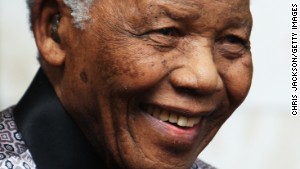 Zuma: This is a moment of deepest sorrow  Nelson Mandela in his own words 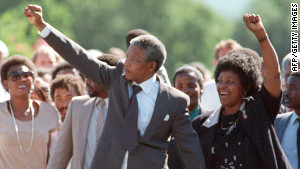 1990: Mandela released from prison 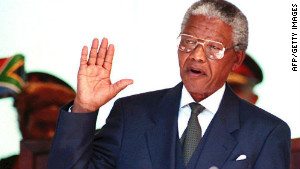 1994: Mandela takes oath of office His defiance of white minority rule and long incarceration for fighting against segregation focused the world's attention on apartheid, the legalized racial segregation enforced by the South African government until 1994. In his lifetime, he was a man of complexities. He went from a militant freedom fighter, to a prisoner, to a unifying figure, to an elder statesman. Years after his 1999 retirement from the presidency, Mandela was considered the ideal head of state. He became a yardstick for African leaders, who consistently fell short when measured against him. Warm, lanky and charismatic in his silk, earth-toned dashikis, he was quick to admit to his shortcomings, endearing him further in a culture in which leaders rarely do. His steely gaze disarmed opponents. So did his flashy smile. Former South African President F.W. de Klerk, who was awarded the Nobel Peace Prize with Mandela in 1993 for transitioning the nation from a system of racial segregation, described their first meeting. "I had read, of course, everything I could read about him beforehand. I was well-briefed," he said. "I was impressed, however, by how tall he was. By the ramrod straightness of his stature, and realized that this is a very special man. He had an aura around him. He's truly a very dignified and a very admirable person." For many South Africans, he was simply Madiba, his traditional clan name. Others affectionately called him Tata, the word for father in his Xhosa tribe. A nation on edge Mandela last appeared in public during the 2010 World Cup hosted by South Africa. His absences from the limelight and frequent hospitalizations left the nation on edge, prompting Zuma to reassure citizens every time he fell sick. "Mandela is woven into the fabric of the country and the world," said Ayo Johnson, director of Viewpoint Africa, which sells content about the continent to media outlets. When he was around, South Africans had faith that their leaders would live up to the nation's ideals, according to Johnson. "He was a father figure, elder statesman and global ambassador," Johnson said. "He was the guarantee, almost like an insurance policy, that South Africa's young democracy and its leaders will pursue the nation's best interests." There are telling nuggets of Mandela's character in the many autobiographies about him. An unmovable stubbornness. A quick, easy smile. An even quicker frown when accosted with a discussion he wanted no part of. War averted Despite chronic political violence before the vote that put him in office in 1994, South Africa avoided a full-fledged civil war in its transition from apartheid to multiparty democracy. The peace was due in large part to the leadership and vision of Mandela and de Klerk. "We were expected by the world to self-destruct in the bloodiest civil war along racial grounds," Mandela said during a 2004 celebration to mark a decade of democracy in South Africa. "Not only did we avert such racial conflagration, we created amongst ourselves one of the most exemplary and progressive nonracial and nonsexist democratic orders in the contemporary world." Mandela represented a new breed of African liberation leaders, breaking from others of his era such as Robert Mugabe by serving one term. In neighboring Zimbabwe, Mugabe has been president since 1987. A lot of African leaders overstayed their welcomes and remained in office for years, sometimes decades, making Mandela an anomaly. But he was not always popular in world capitals. Until 2008, the United States had placed him and other members of the African National Congress on its terror list because of their militant fight against the apartheid regime. Humble beginnings Rolihlahla Mandela started his journey in the tiny village of Mvezo, in the hills of the Eastern Cape, where he was born on July 18, 1918. His teacher later named him Nelson as part of a custom to give all schoolchildren Christian names. His father died when he was 9, and the local tribal chief took him in and educated him. Mandela attended school in rural Qunu, where he retreated before returning to Johannesburg to be near medical facilities. He briefly attended University College of Fort Hare but was expelled after taking part in a protest with Oliver Tambo, with whom he later operated the nation's first black law firm. In subsequent years, he completed a bachelor's degree through correspondence courses and studied law at the University of Witwatersrand in Johannesburg. He left without graduating in 1948. Four years before he left the university, he helped form the youth league of the African National Congress, hoping to transform the organization into a more radical movement. He was dissatisfied with the ANC and its old-guard politics. And so began Mandela's civil disobedience and lifelong commitment to breaking the shackles of segregation in South Africa. Escalating trouble In 1956, Mandela and dozens of other political activists were charged with high treason for activities against the government. His trial lasted five years, but he was ultimately acquitted. Meanwhile, the fight for equality got bloodier. Four years after his treason charges, police shot 69 unarmed black protesters in Sharpeville township as they demonstrated outside a station. The Sharpeville Massacre was condemned worldwide, and it spurred Mandela to take a more militant tone in the fight against apartheid. The South African government outlawed the ANC after the massacre, and an angry Mandela went underground to form a new military wing of the organization. "There are many people who feel that it is useless and futile for us to continue talking peace and nonviolence against a government whose reply is only savage attacks on an unarmed and defenseless people," Mandela said during his time on the run. During that period, he left South Africa and secretly traveled under a fake name. The press nicknamed him "the Black Pimpernel" because of his police evasion tactics. Militant resistance The African National Congress heeded calls for stronger action against the apartheid regime, and Mandela helped launch an armed wing to attack government symbols, including post offices and offices. The armed struggle was a defense mechanism against government violence, he said. "My people, Africans, are turning to deliberate acts of violence and of force against the government in order to persuade the government, in the only language which this government shows by its own behavior that it understands," Mandela said at the time. "If there is no dawning of sanity on the part of the government -- ultimately, the dispute between the government and my people will finish up by being settled in violence and by force. " The campaign of violence against the state resulted in civilian casualties. A white South African's memories of Mandela Long imprisonment In 1962, Mandela secretly received military training in Morocco and Ethiopia. When he returned home later that year, he was arrested and charged with illegal exit of the country and incitement to strike. Mandela represented himself at the trial and was briefly imprisoned before being returned to court. In 1964, after the famous Rivonia trial, he was sentenced to life in prison for sabotage and conspiracy to overthrow the government. At the trial, instead of testifying, he opted to give a speech that was more than four hours long, and ended with a defiant statement. "I have fought against white domination, and I have fought against black domination," he said. "I have cherished the ideal of a democratic and free society in which all persons live together in harmony and with equal opportunities. It is an ideal which I hope to live for and to achieve. But if needs be, it is an ideal for which I am prepared to die." His next stop was the Robben Island prison, where he spent 18 of his 27 years in detention. He described his early days there as harsh. "There was a lot of physical abuse, and many of my colleagues went through that humiliation," he said. One of those colleagues was Khehla Shubane, 57, who was imprisoned in Robben Island during Mandela's last years there. Though they were in different sections of the prison, he said, Mandela was a towering figure. "He demanded better rights for us all in prison. The right to get more letters, get newspapers, listen to the radio, better food, right to study," Shubane said. "It may not sound like much to the outside world, but when you are in prison, that's all you have." And Mandela's khaki prison pants, he said, were always crisp and ironed. "Most of us chaps were lazy, we would hang our clothes out to dry and wear them with creases. We were in a prison, we didn't care. But Mandela, every time I saw him, he looked sharp." After 18 years, he was transferred to other prisons, where he experienced better conditions until he was freed in 1990. Months before his release, he obtained a bachelor's in law in absentia from the University of South Africa. Calls for release His freedom followed years of an international outcry led by Winnie Mandela, a social worker whom he married in 1958, three months after divorcing his first wife. Mandela was banned from reading newspapers, but his wife provided a link to the outside world. She told him of the growing calls for his release and updated him on the fight against apartheid. World pressure mounted to free Mandela with the imposition of political, economic and sporting sanctions, and the white minority government became more isolated. In 1988 at age 70, Mandela was hospitalized with tuberculosis, a disease whose effects plagued him until the day he died. He recovered and was sent to a minimum security prison farm, where he was given his own quarters and could receive additional visitors. Among them, in an unprecedented meeting, was South Africa's president, P.W. Botha. Change was in the air. When Botha's successor, de Klerk, took over, he pledged to negotiate an end to apartheid. South Africa: Following Nelson Mandela Free at last On February 11, 1990, Mandela walked out of prison to thunderous applause, his clenched right fist raised above his head. Still as upright and proud, he would say, as the day he walked into prison nearly three decades earlier. He reassured ANC supporters that his release was not part of a government deal and informed whites that he intended to work toward reconciliation. Four years after his release, in South Africa's first multiracial elections, he became the nation's first black president. "The day he was inducted as president, we stood on the terraces of the Union Building," de Klerk remembered years later. "He took my hand and lifted it up. He put his arm around me, and we showed a unity that resounded through South Africa and the world." Mandela: Patriarch, legend, family man Broken marriage, then love His union to Winnie Mandela, however, did not have such a happy ending. They officially divorced in 1996. For the two, it was a fiery love story, derailed by his ambition to end apartheid. During his time in prison, Mandela wrote his wife long letters, expressing his guilt at putting political activism before family. Before the separation, Winnie Mandela was implicated in violence, including a conviction for being an accessory to assault in the death of a teenage township activist. Mandela found love again two years after the divorce. On his 80th birthday, he married Graca Machel, the widow of former Mozambique president, Samora Machel. Only three of Mandela's children are still alive. He had 18 grandchildren and 12 great-grandchildren. Symbolic rugby South Africa's fight for reconciliation was epitomized at the 1995 rugby World Cup Final in Johannesburg, when it played heavily favored New Zealand. As the dominant sport of white Afrikaners, rugby was reviled by blacks in South Africa. They often cheered for rivals playing their national team. Mandela's deft use of the national team to heal South Africa was captured in director Clint Eastwood's 2009 feature film "Invictus," starring Morgan Freeman as Mandela and Matt Damon as Francois Pienaar, the white South African captain of the rugby team. Before the real-life game, Mandela walked onto the pitch, wearing a green-and-gold South African jersey bearing Pienaar's number on the back. "I will never forget the goosebumps that stood on my arms when he walked out onto the pitch before the game started," said Rory Steyn, his bodyguard for most of his presidency. "That crowd, which was almost exclusively white ... started to chant his name. That one act of putting on a No. 6 jersey did more than any other statement in bringing white South Africans and Afrikaners on side with new South Africa." A promise honored In 1999, Mandela did not seek a second term as president, keeping his promise to serve only one term. Thabo Mbeki succeeded him in June of the same year. After leaving the presidency, he retired from active politics, but remained in the public eye, championing causes such as human rights, world peace and the fight against AIDS. It was a decision born of tragedy: His only surviving son, Makgatho Mandela, died of AIDS at age 55 in 2005. Another son, Madiba Thembekile, was killed in a car crash in 1969. Mandela's 90th birthday party in London's Hyde Park was dedicated to HIV awareness and prevention, and was titled 46664, his prison number on Robben Island. A resounding voice Mandela continued to be a voice for developing nations. He criticized U.S. President George W. Bush for launching the 2003 war against Iraq, and accused the United States of "wanting to plunge the world into a Holocaust." And as he was acclaimed as the force behind ending apartheid, he made it clear he was only one of many who helped transform South Africa into a democracy. In 2004, a few weeks before he turned 86, he announced his retirement from public life to spend more time with his loved ones. "Don't call me, I'll call you," he said as he stepped away from his hectic schedule. 'Like a boy of 15' But there was a big treat in store for the avid sportsman. When South Africa was awarded the 2010 football World Cup, Mandela said he felt "like a boy of 15." In July that year, Mandela beamed and waved at fans during the final of the tournament in Johannesburg's Soccer City. It was his last public appearance. "I would like to be remembered not as anyone unique or special, but as part of a great team in this country that has struggled for many years, for decades and even centuries," he said. "The greatest glory of living lies not in never falling, but in rising every time you fall." With him gone, South Africans are left to embody his promise and idealism. South Africa since apartheid: Boom or bust? CNN's Robyn Curnow, Michael Martinez, Matt Smith and Alanne Orjoux contributed to this report. |

| December
8, 2013 Time Shift Alert G2 Geomagnetic Storm In Progress, M Class Flare, R1 Radio Blackout, Auroras Triggered Time Shift And Time Line Edits In Progress There is so much going on, between the Sun and the Earth - as well as Time Shift activity and memorable Time Shift markers like the December 5, 2013 Time Shift Living Dead death of Nelson Mandela [read my earlier report] - that I knew energy and events were building up. And so it has come to pass, and I can now give you a more comprehensive briefing on what is going on and what it means to us. Yesterday, December 7, 2013, an M1.2 class solar flare erupted from Earth side sunspot 1909. The eruption released an impressive coronal mass ejection [CME] as well as causing an R1 radio blackout on Earth. Because 1909 is located near the Sun's west rim, the bulk of the CME will probably miss Earth - but not entirely. More data is needed to determine this. Meanwhile, the expected solar wind is currently hitting Earth and this has triggered G2 geomagnetic storming and unsettled magnetic field activity. Auroras are dancing in high latitudes. This photo shows the M1.2 CME. Those of you who are particularly sharp should notice something unusual with the photo I'm sharing. I've published it in reverse because the Stereo Ahead space camera took the photo from a position other than from our point of view on Earth. This creates a photo that is the mirror image of how we on Earth would relate to the event. So, to keep solar continuity I reversed the photo. BTW, that blob to the right of the Sun is the planet Venus. Due to the geomagnetic conditions, which can and do trigger Time Shifts, Time Shift and time line edit activity is in progress. Read my Time Shift alerts, including on this wall and on my website, and you'll learn more about the mechanism of Time Shift science. Stay sharp and be as aware as you can of Time Shift markers. These markers are the best evidence that a Time Shift is in progress. |
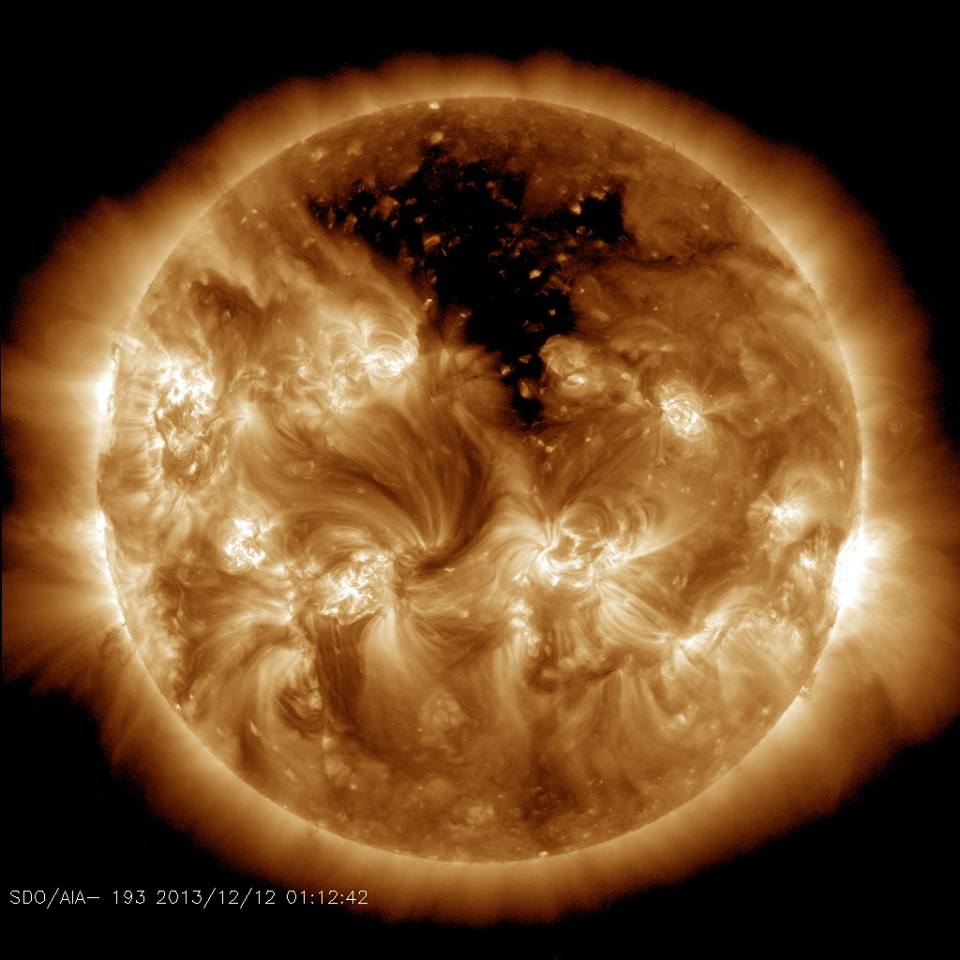
| December
13, 2013 Time Shift Alert: Solar Wind and Multiple CME Activity With Geomagnetic Storms Expected, Time Shift and Time Line Activity Expected, Geminid Meteor Shower In Progress There is a lot going on, between the Sun and the Earth, including a huge Earth facing coronal hole and multiple C class Earth directed coronal mass ejections [CME]. Much of this solar energy is heading our way, in somewhat staggered fashion, with the first wave possibly hitting between December 14-17, 2013. In this SDO photo I'm showing you all what seems to be the most interesting of the lot. Take a look at that huge jaggged edged coronal hole in the Sun's Earth facing northern hemisphere. It has released a solar wind directly at Earth, and like huge coronal holes it releases a solar wind that can be much stronger than smaller coronal holes. When this solar wind hits Earth's magnetosphere, a geomagnetic storm should be triggered. Should this solar wind hit be joined by any of the CMEs, the geomagnetic storming will increase. Any geomagnetic storming is capable of triggering Time Shift and time line edit activity. Meanwhile, Earth is being presented with a space show as the planet is being pelted by the Geminid meteor showers. Along with dozens of meteors per hour zipping by, there have already been about 40 fireballs blazing through our upper atmosphere - with more expected as the meteor shower peaks December 13-14, 2013. An interesting thing about these kind of meteors, is that they can leave meteor dust in our atmosphere that can create beautiful atmospheric colors. Of course, should a meteor survive its travels through our atmosphere and crash into the Earth, that event can cause a tremendous explosion and possible meteor fragments falling to the Earth. These meteor fragments are then called meteorites. So stay sharp and be as aware as you can of Time Shift markers. These markers are the best evidence that a Time Shift is in progress. |
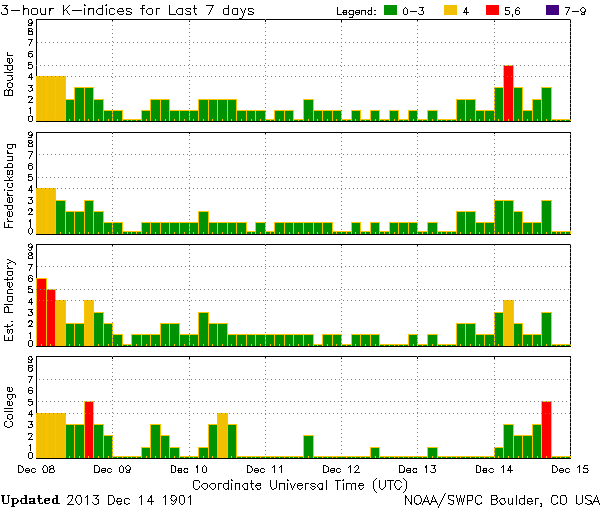
| December
14, 2013 Time Shift Alert: Geomagnetic Storm In Progress Time Shift and Time Line Edit Activity In Progress On my December 13, 2013 Time Shift Alert I brought you up to date with solar activity that i determined would not only cause geomagnetic storming, but because of that was likely to trigger Time Shift and time line edit activity. I wrote that I thought this event would begin as early as December 14, 2013 ... and it has. As you can see in this current k-index chart from NOAA, the Earth is now experiencing geomagnetic storming and unsettled magnetic field conditions. The k-index chart measures the intensity of Earth's magnetic field, including how solar activity impacts Earth's magnetic field. Based on Time Shift marker reports coming in, this Sun-Earth event has indeed triggered Time Shift activity. Please read yesterday's report for more information about the solar activity that is currently in play. In addition, more C class Earth side coronal mass ejections [CME] fired off today, and some of that CME energy is headed to Earth. This energy should arrive in about three days. The earlier Earth facing CME, which I reported about, will be here soon. If nothing happens to interfere with this expected situation, then the staggered hit of more than one CME will act to extend the Time Shift and time line edit activity. So stay sharp and be as aware as you can of Time Shift markers. These markers are the best evidence that a Time Shift is in progress. |
| |
| |
| |
| |
| |
| |
| |
All contents copyright ©2012 by Starfire Tor